Citroen C3 PICASSO 2014 1.G Owner's Manual
Manufacturer: CITROEN, Model Year: 2014, Model line: C3 PICASSO, Model: Citroen C3 PICASSO 2014 1.GPages: 292, PDF Size: 9.23 MB
Page 121 of 292
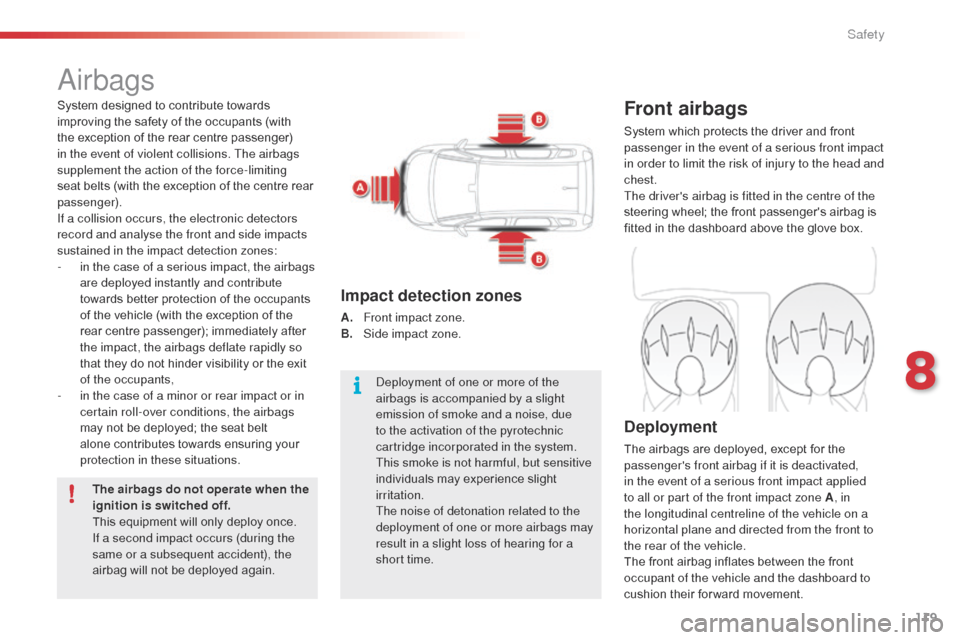
119
C3Picasso_en_Chap08_securite_ed01-2014
airbags
Front airbags
System which protects the driver and front
passenger in the event of a serious front impact
in order to limit the risk of injury to the head and
chest.
The driver's airbag is fitted in the centre of the
steering wheel; the front passenger's airbag is
fitted in the dashboard above the glove box.
Deployment
The airbags are deployed, except for the
passenger's front airbag if it is deactivated,
in the event of a serious front impact applied
to all or part of the front impact zone A, in
the longitudinal centreline of the vehicle on a
horizontal plane and directed from the front to
the rear of the vehicle.
The front airbag inflates between the front
occupant of the vehicle and the dashboard to
cushion their for ward movement.
Impact detection zones
A. Front impact zone.
B. S ide impact zone.
System designed to contribute towards
improving the safety of the occupants (with
the exception of the rear centre passenger)
in the event of violent collisions. The airbags
supplement the action of the force-limiting
seat belts (with the exception of the centre rear
passenger).
If a collision occurs, the electronic detectors
record and analyse the front and side impacts
sustained in the impact detection zones:
-
i
n the case of a serious impact, the airbags
are deployed instantly and contribute
towards better protection of the occupants
of the vehicle (with the exception of the
rear centre passenger); immediately after
the impact, the airbags deflate rapidly so
that they do not hinder visibility or the exit
of the occupants,
-
i
n the case of a minor or rear impact or in
certain roll-over conditions, the airbags
may not be deployed; the seat belt
alone contributes towards ensuring your
protection in these situations.
The airbags do not operate when the
ignition is switched off.
This equipment will only deploy once.
If a second impact occurs (during the
same or a subsequent accident), the
airbag will not be deployed again.
de
ployment of one or more of the
airbags is accompanied by a slight
emission of smoke and a noise, due
to the activation of the pyrotechnic
cartridge incorporated in the system.
This smoke is not harmful, but sensitive
individuals may experience slight
irritation.
The noise of detonation related to the
deployment of one or more airbags may
result in a slight loss of hearing for a
short time.
8
Safety
Page 122 of 292

120
C3Picasso_en_Chap08_securite_ed01-2014
Operating fault
If this warning lamp comes on in the
instrument panel, accompanied by an
audible warning and a message in the
multifunction screen, contact a CITR
o
Ë
n
d
ealer or a qualified workshop without
delay to have the system checked. The
airbags may no longer be deployed in the
event of a serious impact.
Reactivation
When you remove the rear ward facing child
seat, with the ignition off , turn switch 1 to the
"ON" position to reactivate the airbag and so
assure the safety of your front passenger in the
event of an impact.
With the ignition on, this warning lamp
comes on in the instrument panel
or in the seat belt and passenger's
front airbag warning lamp display
for approximately one minute, if the
passenger's front airbag is activated.
According to version, this warning
lamp comes on either in the
instrument panel or on the seat belt
and passenger's front airbag warning
lamp display when the ignition is on
and until the airbag is reactivated.
If this warning lamp flashes, contact a
CITROËN dealer or a qualified workshop
without delay. The passenger's front
airbag may no longer be deployed in the
event of a serious impact.
Deactivation
only the passenger's front airbag can be
deactivated:
F
w
ith the ignition off , insert the key in the
passenger airbag deactivation switch 1 ,
F
t
urn it to the "OFF" position,
F
t
hen, remove the key keeping the switch in
this position. To assure the safety of your child, it is
imperative that the passenger's front
airbag is deactivated when you install a
"rear ward facing" child seat on the front
passenger seat.
Other wise, the child would risk being
seriously injured or killed if the airbag
were deployed.
If at least one of the two airbag
warning lamps come on continuously,
do not install a child seat on the front
passenger seat.
Have it checked by a CITR
oËn
dealer
or a qualified workshop.
Safety
Page 123 of 292

121
C3Picasso_en_Chap08_securite_ed01-2014
Lateral airbags
Deployment
a lateral airbag is deployed unilaterally in the
e vent of a serious side impact applied to all or
part of the side impact zone B, perpendicular
to the longitudinal centreline of the vehicle on a
horizontal plane and directed from the outside
towards the inside of the vehicle.
The lateral airbag inflates between the hip and
shoulder of the front occupant of the vehicle
and the corresponding door trim panel.
Curtain airbags
Deployment
The curtain airbag is deployed at the same
time as the corresponding lateral airbag in the
event of a serious side impact applied to all or
part of the side impact zone B, perpendicular
to the longitudinal centreline of the vehicle on a
horizontal plane and directed from the outside
towards the inside of the vehicle.
The curtain airbag inflates between the front or
rear occupant of the vehicle and the windows.
Impact detection zones
A. Front impact zone.
B. S ide impact zone.
System which protects the driver and front
passenger in the event of a serious side impact
in order to limit the risk of injury to the chest,
between the hip and the shoulder.
Each lateral airbag is fitted in the seat backrest
frame, door side.
System which contributes towards improving
the protection of the driver and passengers
(with the exception of the rear centre
passenger) in the event of a serious side
impact in order to limit the risk of injury to the
side of the head.
Each curtain airbag is built into the pillars and
the upper passenger compartment area.
8
Safety
Page 124 of 292
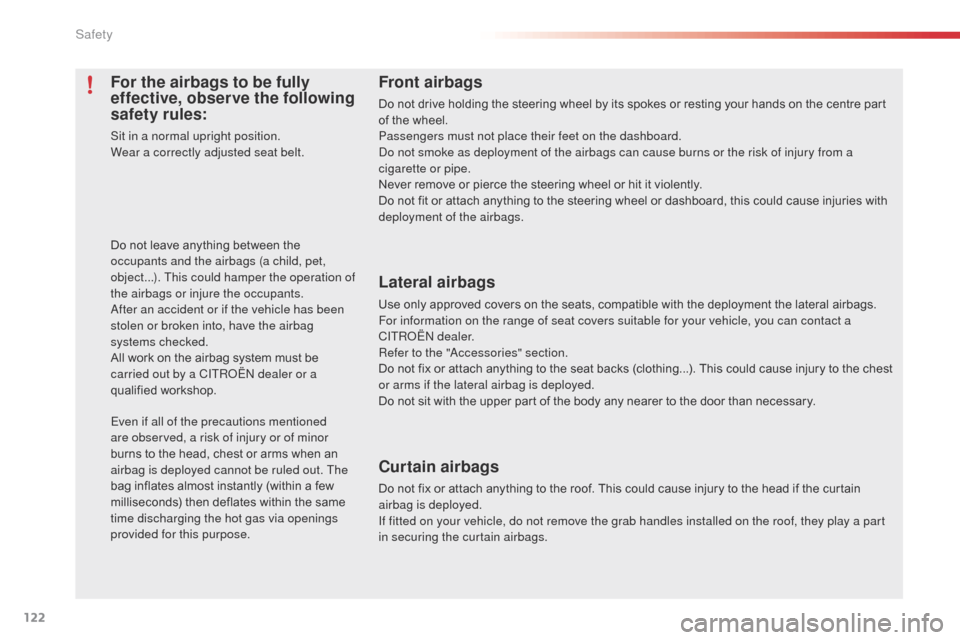
122
C3Picasso_en_Chap08_securite_ed01-2014
Front airbags
Do not drive holding the steering wheel by its spokes or resting your hands on the centre part
of the wheel.
Passengers must not place their feet on the dashboard.
do n
ot smoke as deployment of the airbags can cause burns or the risk of injury from a
cigarette or pipe.
Never remove or pierce the steering wheel or hit it violently.
Do not fit or attach anything to the steering wheel or dashboard, this could cause injuries with
deployment of the airbags.
Lateral airbags
Use only approved covers on the seats, compatible with the deployment the lateral airbags.
For information on the range of seat covers suitable for your vehicle, you can contact a
CITR
oËn
dealer.
Refer to the "
ac
cessories" section.
Do not fix or attach anything to the seat backs (clothing...). This could cause injury to the chest
or arms if the lateral airbag is deployed.
Do not sit with the upper part of the body any nearer to the door than necessary.
Curtain airbags
Do not fix or attach anything to the roof. This could cause injury to the head if the curtain
airbag is deployed.
If fitted on your vehicle, do not remove the grab handles installed on the roof, they play a part
in securing the curtain airbags.
Do not leave anything between the
occupants and the airbags (a child, pet,
object...). This could hamper the operation of
the airbags or injure the occupants.
af
ter an accident or if the vehicle has been
stolen or broken into, have the airbag
systems checked.
All work on the airbag system must be
carried out by a CITR
oËn
dealer or a
qualified workshop.
Even if all of the precautions mentioned
are observed, a risk of injury or of minor
burns to the head, chest or arms when an
airbag is deployed cannot be ruled out. The
bag inflates almost instantly (within a few
milliseconds) then deflates within the same
time discharging the hot gas via openings
provided for this purpose.
For the airbags to be fully
effective, observe the following
safety rules:
Sit in a normal upright position.
Wear a correctly adjusted seat belt.
Safety
Page 125 of 292
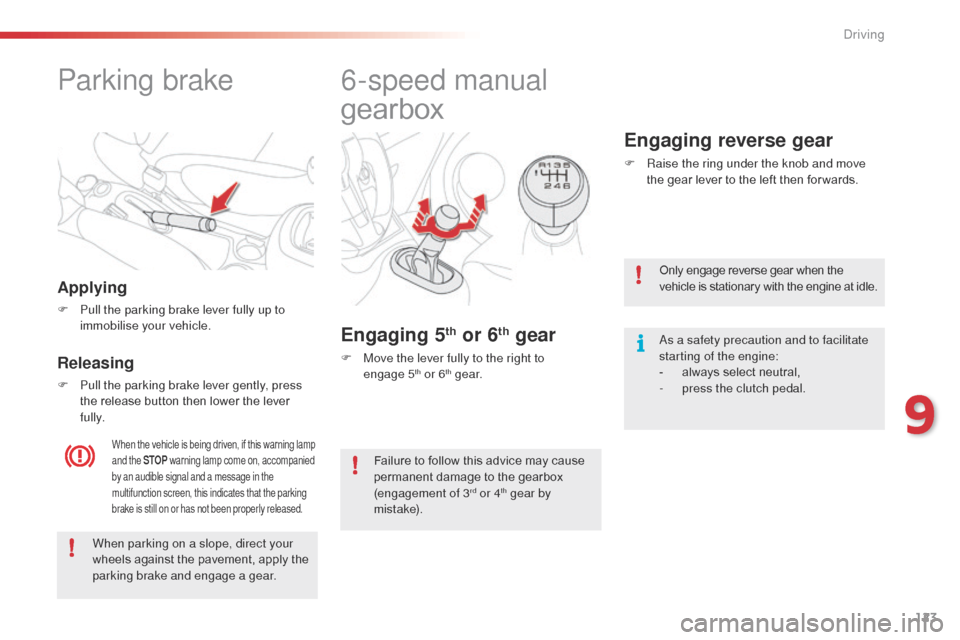
123
C3Picasso_en_Chap09_conduite_ed01-2014
Parking brake
Applying
F Pull the parking brake lever fully up to immobilise your vehicle.
When the vehicle is being driven, if this warning lamp
and the STOP warning lamp come on, accompanied
by an audible signal and a message in the
multifunction screen, this indicates that the parking
brake is still on or has not been properly released.
Releasing
F Pull the parking brake lever gently, press the release button then lower the lever
fully.
6-speed manual
gearbox
Engaging 5th or 6th gear
F Move the lever fully to the right to engage 5th or 6th g e a r.
Engaging reverse gear
F Raise the ring under the knob and move the gear lever to the left then for wards.
When parking on a slope, direct your
wheels against the pavement, apply the
parking brake and engage a gear. Only engage reverse gear when the
vehicle is stationary with the engine at idle.
as a s
afety precaution and to facilitate
starting of the engine:
-
a
lways select neutral,
-
p
ress the clutch pedal.
Failure to follow this advice may cause
permanent damage to the gearbox
(engagement of 3
rd or 4th gear by
m i st a ke).
9
driving
Page 126 of 292
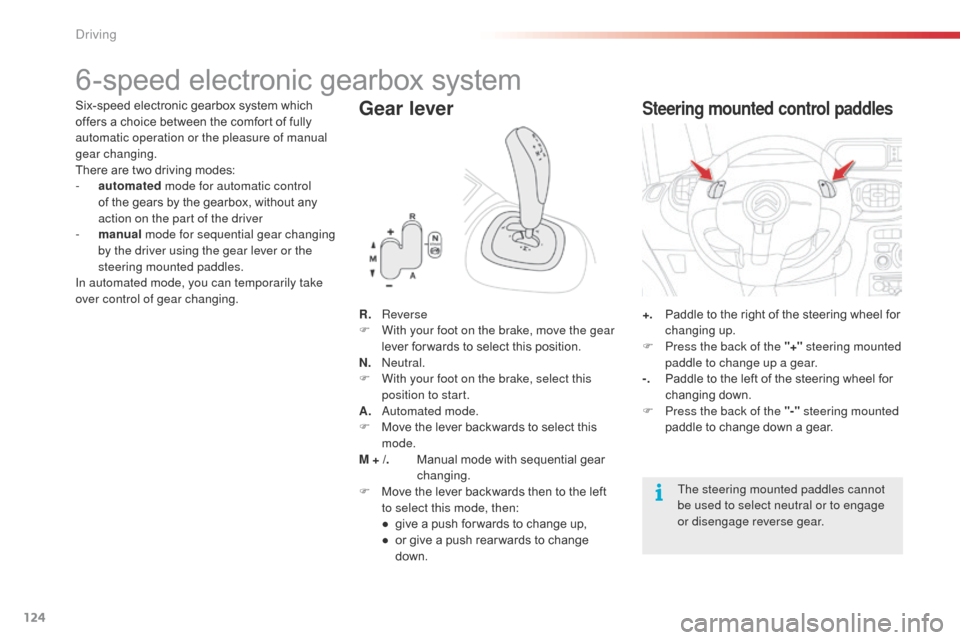
124
C3Picasso_en_Chap09_conduite_ed01-2014
6-speed electronic gearbox system
Six-speed electronic gearbox system which
offers a choice between the comfort of fully
automatic operation or the pleasure of manual
gear changing.
There are two driving modes:
-
a
utomated mode for automatic control
of the gears by the gearbox, without any
action on the part of the driver
-
m
anual mode for sequential gear changing
by the driver using the gear lever or the
steering mounted paddles.
In automated mode, you can temporarily take
over control of gear changing.Gear lever
R. Reverse
F W ith your foot on the brake, move the gear
lever for wards to select this position.
N.
n
e
utral.
F
W
ith your foot on the brake, select this
position to start.
A.
a
u
tomated mode.
F
M
ove the lever backwards to select this
mode.
M + /.
M
anual mode with sequential gear
changing.
F
M
ove the lever backwards then to the left
to select this mode, then:
●
g
ive a push for wards to change up,
●
o
r give a push rear wards to change
down. +. P
addle to the right of the steering wheel for
changing up.
F
P
ress the back of the "+" steering mounted
paddle to change up a gear.
-.
P
addle to the left of the steering wheel for
changing down.
F
P
ress the back of the "-" steering mounted
paddle to change down a gear.
Steering mounted control paddles
The steering mounted paddles cannot
be used to select neutral or to engage
or disengage reverse gear.
driving
Page 127 of 292
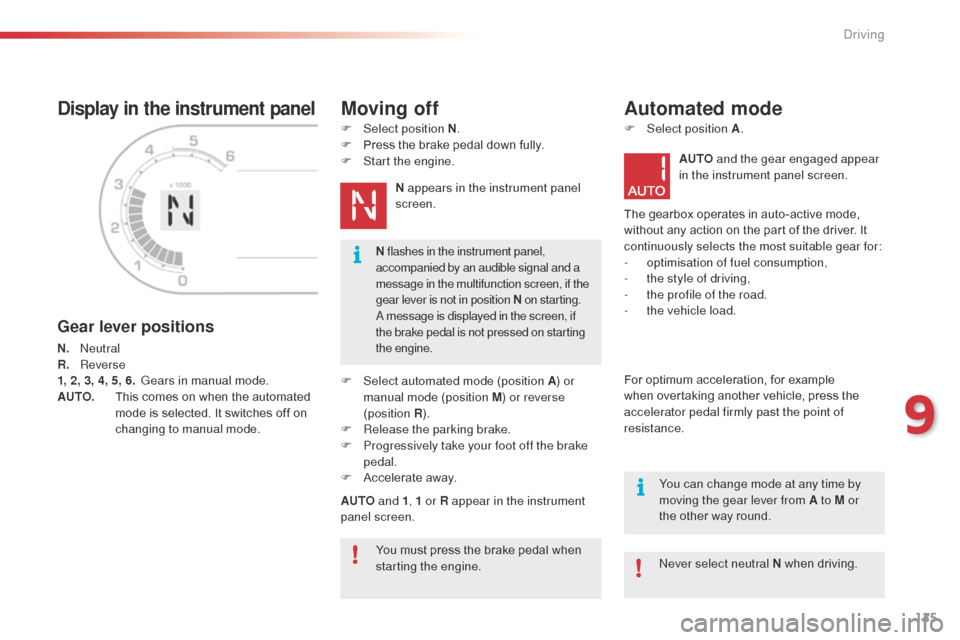
125
C3Picasso_en_Chap09_conduite_ed01-2014
Display in the instrument panel
Gear lever positions
N. neutral
R. R everse
1, 2, 3, 4, 5, 6.
G
ears in manual mode.
AUTO.
T
his comes on when the automated
mode is selected. It switches off on
changing to manual mode.
Moving off
F Select position N .
F P ress the brake pedal down fully.
F
S
tart the engine.N appears in the instrument panel
screen.
F
Sel
ect automated mode (position A ) or
manual mode (position M ) or reverse
(position R ).
F
R
elease the parking brake.
F
P
rogressively take your foot off the brake
pedal.
F
A
ccelerate away.
AUTO and 1, 1 or R appear in the instrument
panel screen.
Automated mode
F Select position A .
AUTO and the gear engaged appear
in the instrument panel screen.
The gearbox operates in auto-active mode,
without any action on the part of the driver. It
continuously selects the most suitable gear for:
-
o
ptimisation of fuel consumption,
-
t
he style of driving,
-
t
he profile of the road.
-
t
he vehicle load.
For optimum acceleration, for example
when overtaking another vehicle, press the
accelerator pedal firmly past the point of
resistance.
You must press the brake pedal when
starting the engine.
ne
ver select neutral N when driving.
N
flashes in the instrument panel,
accompanied by an audible signal and a
message in the multifunction screen, if the
gear lever is not in position N on starting.
a
message is displayed in the screen, if
the brake pedal is not pressed on starting
the engine.
You can change mode at any time by
moving the gear lever from A to M or
the other way round.
9
driving
Page 128 of 292

126
C3Picasso_en_Chap09_conduite_ed01-2014
F Select position M. To engage reverse gear R
, the vehicle must be
immobilised with your foot on the brake pedal.
F
Sel
ect position R.
At very low speed, if reverse gear is requested,
this will only be acted on when the vehicle is
immobilised.
at h
igh speed, if reverse gear is requested,
the
N indicator flashes and the gearbox goes
into neutral. To engage a gear again, put the
gear lever in position A or M .Temporary control of gear
changing
You can temporarily take over control of
gear changing using the "+" and "-" steering
mounted paddles: if the engine speed allows,
the request to change gear is acted on.
This function allows you to anticipate certain
situations such as overtaking a vehicle or the
approach to a corner.
After a few moments without any action on
the control paddles, the gearbox resumes
automatic control of the gears. The gears engaged appear in
succession in the instrument panel
screen.
The gear change requests are only acted on if
the engine speed permits.
It is not necessary to release the accelerator
during gear changes.
When braking or slowing down, the gearbox
changes down automatically to allow the
vehicle to accelerate in the correct gear.
On sharp acceleration, the gearbox will not
change up unless the driver acts on the gear
lever or the steering mounted paddles.
ne
ver select neutral N while the vehicle
is moving. You can change mode at any time, be
moving the gear lever from M to A or
the other way round. Engagement of reverse gear is
accompanied by an audible signal.
Manual mode
Reverse
driving
Page 129 of 292

127
C3Picasso_en_Chap09_conduite_ed01-2014
Stopping the vehicleOperating fault
With the ignition on, the flashing of AUTO ,
accompanied by an audible signal and a
message in the screen, indicates a malfunction
of the gearbox.
Have it checked by a CITR
oËn
dealer or a
qualified workshop.
In all cases when parking, you must
apply the parking brake to immobilise
the vehicle.
When immobilising the vehicle, with
the engine running, you must place the
gear lever in neutral N .
Before carrying out any work in the
engine compartment, ensure that the
gear lever is in neutral N and that the
parking brake is applied.
Before switching off the engine, you can:
-
m
ove to position N to engage neutral,
or
-
l
eave the gear engaged; in this case, it will
not be possible to move the vehicle. If the ambient temperature is
below
-23°C, the engine should be left
running at idle for four minutes, in order
to ensure the correct operation and
durability of the engine and gearbox.
When traversing a flooded road or a
ford, drive at walking pace.
9
driving
Page 130 of 292

128
C3Picasso_en_Chap09_conduite_ed01-2014
Gear shift indicator*
Operation
The system intervenes only when driving
economically.
dep
ending on the driving situation and your
vehicle's equipment, the system may advise
you to skip one or more gears. You can
follow this instruction without engaging the
intermediate gears.
The gear engagement recommendations must
not be considered compulsory. In fact, the
configuration of the road, the amount of traffic
and safety remain determining factors when
choosing the best gear. Therefore, the driver
remains responsible for deciding whether or not
to follow the advice given by the system.
This function cannot be deactivated. Example:
The information appears in the instrument
panel in the form of an arrow accompanied by
the suggested gear. -
Y
ou press the accelerator pedal
moderately.
- T he system may suggest that you engage
a higher gear, if appropriate. In the case of driving which makes
particular demands on the performance
of the engine (firm pressure on the
accelerator pedal, for example, when
overtaking...), the system will not
recommend a gear change.
The system never suggests:
-
e
ngaging first gear,
-
enga
ging reverse gear,
-
e
ngaging a lower gear.
System which reduces fuel consumption by advising the driver to change up.
*
d
ep
ending on engine. -
Y
ou are in third gear.
With an electronic gearbox, the system
is only active in manual mode.
driving